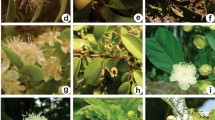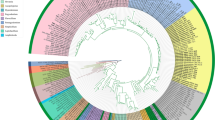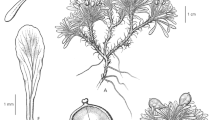Abstract
Ophiostoma quercus is a morphologically variable species that causes sapstain on mostly hardwood hosts worldwide. Several species have been suggested as synonyms of O. quercus in the past, including O. fagi, O. roboris, O. valachicum, O. kubanicum, and O. catonianum. A recent collection of isolates resembling O. quercus from Azerbaijan provided the opportunity to reconsider the accuracy of these synonymies based on morphology and DNA sequence data. Four gene regions, the ribosomal internal transcribed spacer regions including the 5.8 s gene, part of the β-tubulin gene, translation elongation factor-1α, and histone gene, were used to determine the phylogenetic relationships between the various species and isolates of different origin. In all four resulting phylogenetic trees, isolates of O. quercus, O. fagi, and O. roboris formed a single, well-supported cluster, but with some internal variation. All the other species in the analyses, including O. piceae and O. catonianum, grouped distinctly with good node support. These results thus support the synonymy of O. fagi and O. roboris with O. quercus, and confirm that O. piceae and O. catonianum are distinct taxa. Ophiostoma valachicum and O. kubanicum could not be considered due to the absence of cultures, but based on published descriptions, we argue that O. valachicum should be regarded as a valid species in need of neotypification. Ophiostoma kubanicum was never validly described and should be excluded from the list of synonyms of O. quercus.



Similar content being viewed by others
References
Aghayeva DN, Wingfield MJ, de Beer ZW, Kirisits T (2004) Two new Ophiostoma species with Sporothrix anamorphs from Austria and Azerbaijan. Mycologia 96:866–878. doi:10.2307/3762119
Benade E, Wingfield MJ, van Wyk PS (1997) Conidium development in Sporothrix anamorphs of Ophiostoma. Mycol Res 101:1108–1112. doi:10.1017/S0953756297003961
Benade E, Wingfield MJ, van Wyk PS (1998) Conidium development in Hyalodendron and Allescheriella anamorphs of Ophiostoma and Ceratocystiopsis. Mycotaxon 68:251–263
Brasier CM (1993) The genetic system as a taxonomic tool: gene flow, molecular variation and sibling species in the Ophiostoma piceae - Ophiostoma ulmi complex and its taxonomic and ecological significance. In: Wingfield MJ, Seifert KA, Webber J (eds) Ceratocystis and Ophiostoma: taxonomy ecology and pathogenicity. APS, St. Paul, Minnesota, pp 77–92
Brasier CM, Kirk S (1989) European oak decline, identity of Ophiostoma roboris. In: Report on Forest Research: pp 47–48. HMSO, London
Brasier CM, Kirk S (1993) Sibling species within Ophiostoma piceae. Mycol Res 97:811–816. doi:10.1016/S0953-7562(09)81156-8
Brasier C, Stephens TM (1993) Temperature-growth responses distinguish the OPC and OPH sibling species within Ophiostoma piceae. Mycol Res 97:1416–1418. doi:10.1016/S0953-7562(09)80209-8
Carbone I, Kohn ML (1999) A method for designing primer sets for speciation studies in filamentous ascomycetes. Mycologia 91:553–556. doi:10.2307/3761358
Cech T, Donaubauer E, Tomiczek C, Leontovyc R, Yde-Anderson A, Delatour C, Wulf A, Toth J, Vajna L, Vammini A, Luisi N, Oosterbaan A, Kowalski T, Gibbs JN, Jurc D (1990) Oak decline and the status of Ophiostoma spp. on oak in Europe. EPPO Bull 20:405–422. doi:10.1111/j.1365-2338.1990.tb00164.x
Crane JL, Schoknecht JD (1973) Conidiogenesis in Ceratocystis ulmi, Ceratocystis piceae and Graphium penicillioides. Am J Bot 60:346–354. doi:10.2307/2441201
Crous PW, Braun U, Schubert K, Groenewald JZ (2007) Delimiting Cladosporium from morphologically similar genera. Stud Mycol 58:33–56
De Beer ZW, Wingfield BD, Wingfield MJ (2003a) The Ophiostoma piceae complex in the Southern Hemisphere: a phylogenetic study. Mycol Res 107:469–476. doi:10.1017/S0953756203007445
De Beer ZW, Harrington TC, Vismer HF, Wingfield BD, Wingfield MJ (2003b) Phylogeny of the Ophiostoma stenoceras- Sporothrix schenckii complex. Mycologia 95:434–441. doi:10.2307/3761885
De Hoog GS (1974) The genera Blastobotrys, Sporothrix. Calcarisporium and Calcarisporiella gen. nov. Stud Mycol 7:1–84
De Hoog GS (1979) Taxonomic review of Moniliella, Trichosporonoides and Hyalodendron. Stud Mycol 19:1–36
De Meyer EM, de Beer ZW, Summerbell RC, Moharram AM, de Hoog GS, Vismer HF, Wingfield MJ (2008) Taxonomy and phylogeny of new wood- and soil-inhabiting Sporothrix species in the Ophiostoma stenoceras-Sporothrix schenckii complex. Mycologia 100:647–661. doi:10.3852/07-157R
Felsenstein J (1985) Confidence limits on phylogenies: an approach using the bootstrap. Evolution 39:783–791. doi:10.2307/2408678
Gams W (1968) Typisierung der Gattung Acremonium. Nova Hedwigia 16:141–145
Gardes M, Bruns TD (1993) ITS primers with enhanced specificity for basidiomycetes - application to the identification of mycorrhizae and rusts. Mol Ecol 2:113–118. doi:10.1111/j.1365-294X.1993.tb00005.x
Geldenhuis MM, Roux J, Montenegro F, de Beer ZW, Wingfield MJ, Wingfield BD (2004) Identification and pathogenicity of Graphium and Pesotum species from machete wounds on Schizolobium parahybum in Ecuador. Fungal Divers 15:135–149
Georgescu CC, Teodoru I, Badea M (1948) Uscarea in massa a stejarului. Ciupere de alteratie cromatica parazitara a lemnului de stejar. Inst Cercet For Rom 11:185–217
Georgevitch P (1926) Ceratostomella querci n. sp. C R Acad Sci 183:759–761
Georgevitch P (1927) Ceratostomella quercus n. sp. Ein Parasit der slawonischen Eichen. Biol Gen 3:245–252
Georgiev D (1986) Species composition, morphology and certain cultural properties of the agents of the tracheomycosis on the sessile and pedunculate oak in south Bulgaria. Gorskostop Nauk 23:62–69 (In Bulgarian with English summary)
Glass NL, Donaldson GC (1995) Development of primer sets designed for use with the PCR to amplify conserved genes from filamentous Ascomycetes. Appl Environ Microbiol 61:1323–1330
Glenn AE, Bacon CW, Price R, Hanlin RT (1996) Molecular phylogeny of Acremonium and its taxonomic implications. Mycologia 88:369–383. doi:10.2307/3760878
Goidánich G (1935) Uno nuova specie di Ophiostoma vivente sul pero ed alcune osservazioni sull’esatta posizione sistematica della forma ascofora e delle forme metagenetiche del genere. Bolletino Stazione Patol Vegetale Roma Boll Stn Patol Veg Roma 15:122–168
Guindon S, Gascuel O (2003) A simple, fast, and accurate algorithm to estimate large phylogenies by maximum likelihood. Syst Biol 52:696–704. doi:10.1080/10635150390235520
Guseinov ES (1984) Vascular dieback of oaks in Azerbaijan. I. Mikol Fitopatol 18:144–149
Halmschlager E, Messner R, Kowalski T, Prillinger H (1994) Differentiation of Ophiostoma piceae and Ophiostoma quercus by morphology and RAPD analysis. Syst Appl Microbiol 17:554–562
Harrington TC, McNew D, Steimel J, Hofstra D, Farrell R (2001) Phylogeny and taxonomy of the Ophiostoma piceae complex and the Dutch elm disease fungi. Mycologia 93:111–136. doi:10.2307/3761610
Hawksworth DL, Sutton BC, Ainsworth GC (eds) (1983) Dictionary of the fungi. CMI, Kew, Surrey, UK
Hunt J (1956) Taxonomy of the genus Ceratocystis. Lloydia 19:1–58
Hutchison LJ, Reid J (1988) Taxonomy of some potential wood-staining fungi from New Zealand 1. Ophiostomataceae. NZ J Bot 26:63–81
Jacobs K, Bergdahl DR, Wingfield MJ, Halik S, Seifert KA, Bright DE, Wingfield BD (2004) Leptographium wingfieldii introduced into North America and found associated with exotic Tomicus piniperda and native bark beetles. Mycol Res 108:411–418. doi:10.1017/S0953756204009748
Kamgan Nkuekam G, Jacobs K, de Beer ZW, Wingfield MJ, Roux J (2008a) Ceratocystis and Ophistoma species, including three new taxa, associated with wounds on native South African trees. Fungal Divers 29:37–59
Kamgan Nkuekam G, Jacobs K, de Beer ZW, Wingfield MJ, Roux J (2008b) Pesotum australi sp. nov. and Ophiostoma quercus associated with Acacia mearnsii trees in Australia and Uganda, respectively. Australas Plant Pathol 37:406–416. doi:10.1071/AP08027
Katoh K, Kuma K-I, Toh H, Miyata T (2005) MAFFT version 5: improvement in accuracy of multiple sequence alignment. Nucleic Acids Res 33:511–518. doi:10.1093/nar/gki198
Kim SH, Breuil C (2001) Common nuclear ribosomal internal transcribed spacer sequences occur in the sibling species Ophiostoma piceae and O. quercus. Mycol Res 105:331–337. doi:10.1017/S0953756201003422
Kim SH, Uzunovic A, Breuil C (1999) Rapid detection of Ophiostoma piceae and O. quercus in stained wood by PCR. Appl Environ Microbiol 65:287–290
Kirisits T (2004) Fungal associates of European bark beetles with special emphasis on the Ophiostomatoid fungi. In: Lieutier F, Day KR, Battisti A, Grégoire J-C, Evans H (eds) Bark and wood boring insects in living trees in Europe, a synthesis. Kluwer Academic, Dordrecht, pp 181–235
Kowalski T, Butin H (1989) Taxonomie bekannter und neuer Ceratocystis-Arten an Eiche (Quercus robur L.). J Phytopathol 124:236–248
Lehmann E (1932) Ceratostomella quercus Georgevitch in der schwäbischen Alb. Zentralbl Bakteriol Parasitenk Infektionkrankh Hyg II 86:404–407
Lim YW, Alamouti SM, Kim J, Lee S, Breuil C (2004) Multigene phylogenies of Ophiostoma clavigerum and closely related species from bark beetle-attacked Pinus in North America. FEMS Microbiol Lett 237:89–96. doi:10.1111/j.1574-6968.2004.tb09682.x
Lin TC, Huang JW, Hsieh WH (2003) Identification of ophiostomatoid fungi associated with Chinese fir wilt in Taiwan. Plant Pathol Bull 12:33–42 in Chinese
Linnakoski R, de Beer ZW, Rousi M, Niemelä P, Pappinen A, Wingfield MJ (2008) Fungi including Ophiostoma karelicum sp. nov., associated with Scolytus ratzeburgi infesting birch in Finland and Russia. Mycol Res 112:1475–1488. doi:10.1016/j.mycres.2008.06.007
Loos W (1932) Über eine buchenholzbewohnende Ceratostomella, Ceratostomella fagi nov. sp. Arch Mikrobiol 3:370–383. doi:10.1007/BF00454976
McNeill J, Barrie FR, Burdet HM, Demoulin V, Hawksworth DL, Marhold K, Nicolson DH, Prado J, Silva PC, Skog JE, Wiersema JH, Turland NJ (2006) International Code of Botanical Nomenclature (Vienna Code) adopted by the Seventeenth International Botanical Congress Vienna, Austria, July 2005. Regnum Vegetabile 146
Melin E, Nannfeldt JA (1934) Researches into the blueing of ground wood-pulp. Sven Skogsvardsforen Tidskr 32:397–616
Morelet M (1992) Ophiostoma querci sur chêne en France. Ann Soc Sci Nat Archeol Toulon 44:109–112
Morrison DA (2006) Multiple sequence alignment for phylogenetic purposes. Aust Syst Bot 19:479–539. doi:10.1071/SB06020
Münch E (1907) Die Blaufäule des Nadelholzes. I. Naturwiss Z Forst Landwirtsch 5:531–573
Nylander JAA (2004) MrModeltest v.2. Program distributed by the author. Evolutionary Biology Centre, Uppsala University, Uppsala
O’Donnell K, Cigelnik E (1997) Two divergent intragenomic rDNA ITS2 types within a monophyletic lineage of the fungus Fusarium are nonorthologous. Mol Phylogenet Evol 7:103–116. doi:10.1006/mpev.1996.0376
Okada G, Seifert KA, Takematsu A, Yamaoka Y, Miyazaki S, Tubaki K (1998) A molecular phylogenetic reappraisal of the Graphium complex based on 18 S rDNA sequences. Can J Bot 76:1495–1506. doi:10.1139/cjb-76-9-1495
Pipe ND, Buck KW, Brasier CM (1995) Genomic fingerprinting supports the separation of Ophiostoma piceae into two species. Mycol Res 99:1182–1186. doi:10.1016/S0953-7562(09)80274-8
Posada D, Crandall KA (1998) MODELTEST: testing the model of DNA substitution. Bioinform 14:817–818. doi:10.1093/bioinformatics/14.9.817
Potlajczuk VI (1957) On the biology of the causal agent of oak wilt. Tr Vses Naucn-Issled Inst Zascity Rast 8:227–237
Potlajczuk VI, Schekunova EG (1985) De distributione specierum generic Ceratocystis Ell. et Halst. emend. Bakshi in URSS. Nov Sist Rast Akad Nauk SSSR 22:148–156
Przybyl K, de Hoog GS (1989) On the variability of Ophiostoma piceae. Antonie Leewenhoek 55:177–188. doi:10.1007/BF00404757
Przybyl K, Morelet M (1993) Morphological differences between Ophiostoma piceae and O. querci, and among O. querci isolates. Cryptogam Mycol 14:219–228
Riddell RW (1950) Permanent stained mycological preparations obtained by slide culture. Mycologia 42:265–270. doi:10.2307/3755439
Roets F, de Beer ZW, Wingfield MJ, Crous PW, Dreyer LL (2008) Ophiostoma gemellus and Sporothrix variecibatus from mites infesting Protea infructescences in South Africa. Mycologia 100:496–510. doi:10.3852/07-181R
Romón P, Zhou X, Iturrondobeitia JC, Wingfield MJ, Goldarazena A (2007) Ophiostoma species (Ascomycetes: Ophiostomatales) associated with bark beetles (Coleoptera: Scolytinae) colonizing Pinus radiata in northern Spain. Can J Microbiol 53:756–767. doi:10.1139/W07-001
Ronquist F, Huelsenbeck JP (2003) MRBAYES 3: Bayesian phylogenetic inference under mixed models. Bioinform 19:1572–1574. doi:10.1093/bioinformatics/btg180
Schroeder S, Kim SH, Cheung WT, Sterflinger K, Breuil C (2001) Phylogenetic relationship of Ophiostoma piliferum to other sapstain fungi based on the nuclear rRNA gene. FEMS Microbiol Lett 195:163–167. doi:10.1111/j.1574-6968.2001.tb10515.x
Sczerbin-Parfenenko AL (1953) Rakovye i sosudistye bolezni listvennych porod. Goslesbumizdat, Moskva-Leningrad
Thwaites JM, Farrell RL, Duncan SM, Reay SD, Blanchette RA, Hadar E, Hadar Y, Harrington TC, McNew D (2005) Survey of potential sapstain fungi on Pinus radiata in New Zealand. NZ J Bot 43:653–663
Upadhyay HP (1981) A monograph of Ceratocystis and Ceratocystiopsis. University of Georgia Press, Athens, Georgia, USA
Webber JF, Brasier CM (1991) Status of Ophiostoma piceae on hardwoods and conifers. In: Report on Forest Research 1990. HMSO, London, UK, pp 54-55
White TJ, Bruns T, Lee S, Taylor J (1990) Amplification and direct sequencing of fungal ribosomal RNA genes for phylogenetics. In: Innis MA, Gelfand DH, Sninsky JJ, White TJ (eds) PCR protocols: a guide to methods and application. Academic Press, San Diego, pp 315–322
Zhou XD, de Beer ZW, Ahumada R, Wingfield BD, Wingfield MJ (2004) Ophiostoma and Ceratocystiopsis spp. associated with two pine-infesting bark beetles in Chile. Fungal Divers 15:261–274
Zhou XD, de Beer ZW, Wingfield MJ (2006) DNA sequence comparisons of Ophiostoma spp., including Ophiostoma aurorae sp. nov., associated with pine bark beetles in South Africa. Stud Mycol 55:269–277
Acknowledgements
We are deeply grateful to our colleagues and curators of herbaria for supplying cultures and specimens without which this study could not have been undertaken. We thank Dr Danut Chira of the Forest Research and Management Institute (ICAS), Romania, for providing us with literature and the English translation of the species diagnoses of O. roboris from Romania, and Dr Hugh Glen and Prof J.P. van der Walt for their helpful advice concerning Latin grammar. We also thank Mr Chris van der Merwe of the Laboratory for Microscopy and Microanalysis, School of Physical Sciences, University of Pretoria, who assisted us with scanning electron microscopy. We are indebted to Dr Thomas Kirisits for advice on an earlier draft of the manuscript. We thank Dr Ursula Heiniger, Swiss Federal Institute and the SCOPES Programme 2000-2003 (Scientific Co-operation Programme between Eastern Europe and Switzerland, Swiss National Research Foundation, Grant: 7CO 064552) for support. We also acknowledge members of the Tree Protection Cooperative Programme (TPCP), Centre for Tree Health Biotechnology (CTHB), the National Research Foundation (NRF), and the THRIP initiative of the Department of Trade and Industry, South Africa for financial assistance.
Author information
Authors and Affiliations
Corresponding author
Additional information
Taxonomic noveltiesPesotum roboris (Georgescu, Teodoru and Badea) Grobbelaar, Z.W. de Beer and M.J. Wingf.; Sporothrix roboris (Georgescu, Teodoru and Badea) Grobbelaar, Z.W. de Beer and M.J. Wingf.
Rights and permissions
About this article
Cite this article
Grobbelaar, J.W., Aghayeva, D.N., de Beer, Z.W. et al. Delimitation of Ophiostoma quercus and its synonyms using multiple gene phylogenies. Mycol Progress 8, 221–236 (2009). https://doi.org/10.1007/s11557-009-0594-4
Received:
Revised:
Accepted:
Published:
Issue Date:
DOI: https://doi.org/10.1007/s11557-009-0594-4




